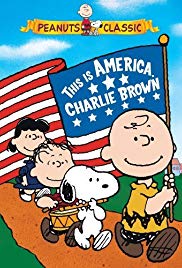THIS IS AMERICA CHARLIE BROWN
THE BUILDING OF THE TRANSCONTINENTAL RAILROAD
SUBJECTS — U.S./1865 – 1913.
SOCIAL-EMOTIONAL LEARNING — None.
MORAL-ETHICAL EMPHASIS — General.
AGE: 8 – 11
No MPAA Rating; Animated; 24 minutes; 1989; Color.
There is NO AI content on this website. All content on TeachWithMovies.org has been written by human beings.

THE BUILDING OF THE TRANSCONTINENTAL RAILROAD
SUBJECTS — U.S./1865 – 1913.
SOCIAL-EMOTIONAL LEARNING — None.
MORAL-ETHICAL EMPHASIS — General.
AGE: 8 – 11
No MPAA Rating; Animated; 24 minutes; 1989; Color.
The Peanuts gang describes the building of the transcontinental railroad (1866 – 1869).
Children will enjoy this film even if they are not familiar with the Peanuts characters.
Selected Awards: None.
Featured Actors: None.
Director: Sam Nicholson.
This film will introduce children to the effort to link the East and West coasts of the United States by rail.
None.
Your child will be intrigued to learn that this cartoon has some relationship to real events. Review the Helpful Background section and talk about the transcontinental railroad. You will not be able to cover everything but do the best you can. Immediately after the movie, or at odd times over the next week (for example at the dinner table or in the car on the way to school) bring up some of the Discussion Questions, starting with the Quick Discussion Question. Don’t worry if you can only get through a few questions. Just taking the film seriously and discussing it is the key. Allow your child to watch the movie several times and continue to ask and help him or her answer more discussion questions.
To enhance the educational value of this cartoon, parents or teachers need only watch the film with their children and comment on two or three points made in the film. Additional helpful background is set out below.
Beginning in the 1830s, visionaries advocated construction of a transcontinental railroad. At that time, trade with the West Coast required either an arduous trip by land across the continent or a long ocean voyage around Cape Horn. Proponents of the transcontinental railroad argued that it would increase U.S. influence in the West and provide economic benefits not only to the West but also to points along the route. The settlement of the Oregon boundary dispute in 1846, the acquisition of Western territories through the Mexican war in 1848, and the California Gold Rush of 1849 increased the need for a transcontinental rail link.
In 1853, Congress ordered the government to study possible rail routes to the West. The two primary options were a northern railway from St. Louis to Northern California and a southern line from New Orleans to Southern California. Sectional rivalry between North and South prevented any decision on which route to build. When the South seceded from the Union, Congress enacted a law mandating the northern option. In 1862, President Lincoln signed the Pacific Railroad Act, which granted charters to the Union Pacific and Central Pacific railroad companies. The Union Pacific was to build west from Omaha, Nebraska, the western terminus for the railroad network that already existed. The Central Pacific was to start laying track east from Sacramento through the Sierra Nevada. The railroads were to be joined where they met. The Act gave the railroad companies generous grants of public land along the right of way and loans for each mile of track laid.
In 1863, the Central Pacific Railroad began laying track east from Sacramento. Work in the beginning was slow and difficult. After the first 23 miles, the Central Pacific faced terrain that rose 7,000 feet in 100 miles. Eventually the Central Pacific employed 25,000-30,000 laborers imported from China. Because of the Civil War and a shortage of funds, the project got off to a slow start, especially in the East. In 1865, after the conclusion of the Civil War, construction began to move forward more quickly. The Union Pacific Railroad used Irish immigrants and former soldiers as the bulk of its labor force.
Passenger train service began five days after the golden spike joined the two rail lines. The fare from Omaha to Sacramento was $40 for immigrant class, $80 for second class, and $111 for first class. The trip was scheduled to take four days but there were often delays for track problems, mechanical breakdowns, Indian raids, and robberies.
In 1881, a second transcontinental railroad was completed and the number grew to five in the ensuing years. With increased competition from trucking, five transcontinental rail lines proved unnecessary. The tracks of the original railroad, laid in the 1860s, were torn up for scrap metal.
Discussion Questions Relating to Ethical Issues will facilitate the use of this film to teach ethical principles and critical viewing. This Six Pillars of Ethical Conduct are set out below.
(Be honest; Don’t deceive, cheat or steal; Be reliable — do what you say you’ll do; Have the courage to do the right thing; Build a good reputation; Be loyal — stand by your family, friends and country)
(Treat others with respect; follow the Golden Rule; Be tolerant of differences; Use good manners, not bad language; Be considerate of the feelings of others; Don’t threaten, hit or hurt anyone; Deal peacefully with anger, insults, and disagreements)
(Do what you are supposed to do; Persevere: keep on trying!; Always do your best; Use self-control; Be self-disciplined; Think before you act — consider the consequences; Be accountable for your choices)
(Play by the rules; Take turns and share; Be open-minded; listen to others; Don’t take advantage of others; Don’t blame others carelessly)
(Be kind; Be compassionate and show you care; Express gratitude; Forgive others; Help people in need)
(Do your share to make your school and community better; Cooperate; Stay informed; vote; Be a good neighbor; Obey laws and rules; Respect authority; Protect the environment)
Last updated December 17, 2009.